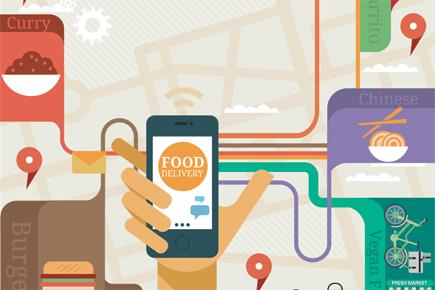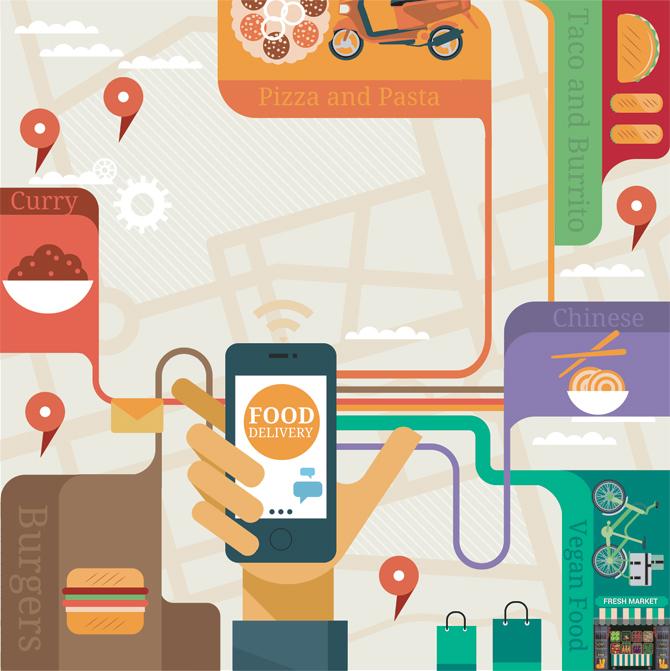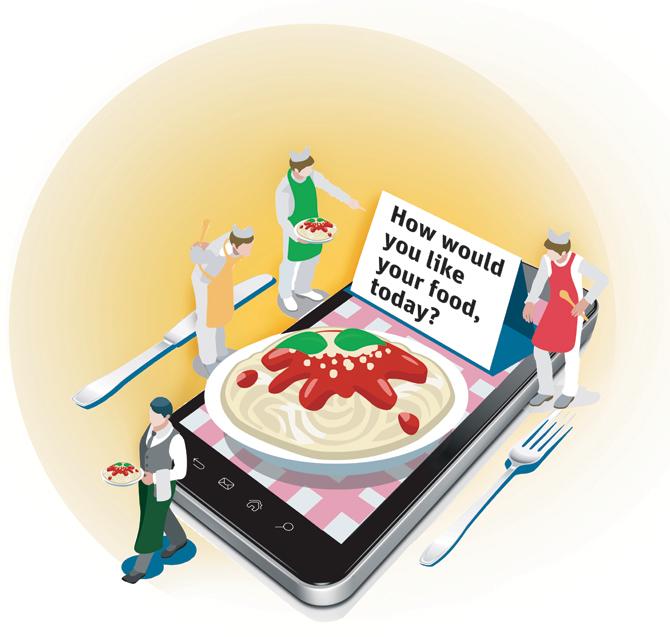The app that delivers your dinner home in minutes killed the ‘home delivery’ call. A look at how intricate technology systems are metamorphosing the Indian food industry

Food delivery app
![]() It’s 10 pm. While most people have left their offices and are heading home, 27-year-old Monish Moorthy is still at work in his Andheri office, sifting through the trending tweets on Twitter. He’s hungry but too occupied to step out for a bite. He reaches for his smartphone and opens the TinyOwl app. After a few minutes of browsing, he isn’t satisfied. Next, he checks the Holachef app that offers food whipped up by home chefs and trained chefs.
It’s 10 pm. While most people have left their offices and are heading home, 27-year-old Monish Moorthy is still at work in his Andheri office, sifting through the trending tweets on Twitter. He’s hungry but too occupied to step out for a bite. He reaches for his smartphone and opens the TinyOwl app. After a few minutes of browsing, he isn’t satisfied. Next, he checks the Holachef app that offers food whipped up by home chefs and trained chefs.

ADVERTISEMENT
“Usually, there are more discounts on Foodpanda, but I prefer Holachef. Most food aggregators (apart from TinyOwl Home Made) offer restaurant food, which I don’t like. With Holachef, I get food directly from kitchens or chefs,” he reasons. Moorthy is one of the many Mumbaikars, who have found relief, thanks to food aggregators like Foodpanda, Zomato, TinyOwl, Hola Chef and CyberChef. There are also independent apps such as Faasos, Box8, Noodle Play, that broadly follow similar processes.

Paid perfect
After selecting his meal, Moorthy, a content manager with Experience Commerce, pays via his PayTM wallet and slips back to work on his laptop. Though a restaurant is a five-minute walk from his office, Moorthy stays put. Why? It’s not just about the food, but also the preference of paying online via an app. “Even if I have cash, I prefer to pay online as it’s convenient. Besides, I can use my debit or credit card, or mobile wallet. It’s also why I don’t order from TinyOwl Home Made. They offer just COD (cash on delivery),” he adds. Several mobile wallets or payment systems have emerged in the last few years, catering to online services like Holachef, such as PayU, Citrus (which offers the backend support to PayTM), Paynear and ePaisa, among others. Bengaluru-based MOMOE Xpress claims to have a nearly three-lakh user base, and have plans to enter Mumbai in two months. “In Bengaluru, we’ve covered over 2,500 outlets — from chaiwallahs on cycles, to auto garages, local groceries and high-end fashion retail outlets. We hope to replicate this in Mumbai,” shares Siddhart Nair, sales manager, MOMOE.
Service matters
Back in Mumbai, within a minute of his making the payment, Moorthy receives a message: ‘Your order is confirmed. It will be delivered in 30 minutes.’
Holachef has created its own hybrid system that allows them to manage various processes of the business. “Our menu is pre-determined, but changes daily. Our company app allows us to communicate with our chefs, who post their dishes with its quantities daily. Once it’s determined, we upload it online. Dishes go on sale automatically, after we receive a fixed number of orders,” informs Anil Gelra, Co-founder and CTO, Holachef.
Nearly 18 kilometers away, in Lalbaug, 28-year-old professional, Biney Koul is scanning restaurant menus on Zomato Order, a new app that the restaurant locator website launched recently to tackle the popularity of other food aggregators. He follows a similar process. He selects a dish from a local food joint, pays via card, and minutes later, receives a confirmation message.
The message comes from the food aggregator, where another professional, like Koul, was checking on a monitor for fresh updates on new orders. At the same time, the eatery beside Koul’s office, receives a similar message on a tablet that was shared by the food aggregator. He checks with his kitchen manager for the orders.
Kitchen confidential
Inside the kitchen, the manager gets details about the order, checks the inventory on his app, and confirms the items on order. The restaurant manager, having received confirmation from his kitchen confirms the order via the app. The system at the food aggregator notifies Koul of the order: ‘Your order is confirmed. It will be delivered in 30 minutes.’
This assembly line precision is managed either by a hybrid restaurant and supply chain management system or pre-designed variants like those offered by companies like Posist, Point Shelf or SmartHotels. These companies offer software that automates every process — from taking orders within a hotel/online to informing kitchen heads of
existing inventory, to probable replacement dates, and also ensures retaining of uniform quality of food by digitising recipes and cooking methods.
For some reason, if a restaurant manager fails to confirm an order, an executive from the food aggregator will call for confirmation. The food aggregator earns a certain percentage of the order value as commission. The restaurant will receive his payment within a day.
Delivery does the trick
Meanwhile, a delivery boy from Grab.in receives an intimation on his company smartphone that a delivery package would be ready in 10 minutes: Along with the intimation, he receives details about the pick-up point, and route map to the restaurant and the delivery point. “We have a company app that gives details about the pick-up location and delivery destination to the delivery boy, and shortest routes to reach there. The app also sends his name and number to the aggregator, and gathers his location on a regular basis, which is provided to the consumer via an API, integrated into the food delivery app,” says Pratish Sanghvi, co-founder of Grab.in. The company currently manages food delivery services for Zomato in 12 Indian cities, and also for multi-city chains like Faasos and Burger King.
An important part of the restaurant business, today, is to gauge consumer behaviour, and to maintain a lively presence online. This need has resulted in new companies like MassBlurb who offer one-stop solutions to meet all the online needs of restaurants.
“We offer services like website management, listings on different food aggregators, social network promotion, search rankings and analytics over all this, for a monthly rental,” says Pankit Chheda, co-founder, MassBlurb. Based out of Andheri, MassBlurb witnesses an annual turnover of R30 lakh, with over 270 businesses on board, of which 100-120 are from Mumbai.
Customer is king
“Today, most customer discoveries are online. Be it visiting a restaurant or ordering via an app, the first thing that customers do is check about a restaurant online. Hence, it’s vital to get the correct presence and information. Analytics help businesses figure their standing among competition,” affirms Chheda.
Keeping an eye on consumer behaviour via social media and customer feedback helped Holachef gain insight into the importance of packaging. The company’s carry bags are a huge craze among users, and its Twitter page is filled with consumer photos. “Our bags have are crucial to brand building. In the one year, many have told us that they love our bags because they are durable and brightly coloured,” adds Gelra.
But it’s not all smooth riding on this technology wave. Companies like MassBlurb have been facing difficulties in making people understand the system. “India’s F&B industry is small scale; most of which still runs traditionally, where the owner doubles up as the cashier. People have low patience levels and want immediate returns. But computer analytics, online promotions and marketing needs time to produce results. And people don’t seem to have it,” summarises Chheda.
 Subscribe today by clicking the link and stay updated with the latest news!" Click here!
Subscribe today by clicking the link and stay updated with the latest news!" Click here!







